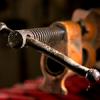I want to start sharpening my own saws. I ordered a set of Grobet saw files and I'm going to make a saw vice. I'll still need to acquire a saw set but otherwise I'll have everything I need.
The first saw I'm going to attempt is a rip backsaw. I'm considering a progressive pattern so it will start easily at the toe but be aggressive and fast in the center and heel. My thoughts are to make the first inch a passive rake, second inch moderate rake, remainder of the saw aggressive rake.
The second saw on the list is an 10 pt Diston rip saw. It's not a valuable saw but it seems well made and just needs a sharpening. I want to do a progressive rake on this saw as well but probably over the first 3" or so.
I want to make some guide blocks for the file end to help me keep the file at the correct angle. I saw them on a Ron Herman vid and also here at SMC. I'll probably make fancy one like this (or 3). What I don't know is what angles to use. What's a good passive rake for each of these saws? What's moderate and what's an aggressive rake?





 Reply With Quote
Reply With Quote






